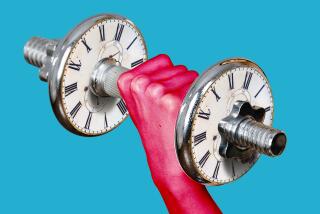Raise your rate
- Share via
So you’re determined to exercise but you can’t possibly do it all -- the strength training with weights, the yoga for flexibility, the brisk walking, running, swimming for cardiovascular fitness. What’s most important?
Simple: The aerobic, cardiovascular stuff. In other words, getting your heart rate up. This doesn’t mean strength training is not important -- it is, for building muscle mass and stronger bones. Stretching and flexibility are important too.
But if you have to choose, do the exercise that has been shown overwhelmingly to prolong life and reduce chronic disease.
Several epidemiological studies show that 30 minutes a day of moderately intense physical activity is enough to significantly reduce the risk of many diseases, including heart disease, hypertension, stroke, diabetes, certain cancers and hip fractures, said Dr. I-Min Lee, an associate professor at Harvard Medical School.
That may not be enough to achieve and maintain weight loss, cautioned William J. Evans, chief of the nutrition, metabolism and exercise lab at the University of Arkansas for Medical Sciences.
“But there is no question that 30 minutes a day is enough to make a significant difference in life expectancy and health,” he said.
That goal comes from guidelines set in 1995, when a team of exercise physiologists and doctors from the federal Centers for Disease Control and Prevention and the American College of Sports Medicine and others tried to figure out what to recommend for average Americans, most of whom, then as now, didn’t exercise.
Though they recommended 30 minutes a day, they softened this by saying people could “accumulate” 30 minutes in three bouts of 10 minutes each, a more achievable goal for many people.
The new federal guidelines expected this summer will probably recommend the same. The difference, said Dr. Bill Kraus, a cardiologist and exercise guru at Duke University Medical Center, is that “when those [1995] guidelines were written, no one had a clue.”
Today, they do, especially on the question of intermittent versus continuous exercise.
In one study published in 1999, exercise physiologist John Jakicic at the University of Pittsburgh found that for weight loss, body composition, improvements in blood pressure, cholesterol and blood sugar, it made no difference whether the exercise was continuous or intermittent. That makes sense, he said, because those factors “are all about energy burn.”
The only place in which continuous exercise was better was in fitness measures, like one that physiologists called “VO2 max,” a measure of the efficiency with which the heart and lungs get oxygen to the muscles and the efficiency with which the muscles use oxygen.
For weight control, a report in 2002 from the Institute of Medicine, an arm of the National Academy of Sciences, concluded that 30 minutes of exercise a day is “insufficient” to maintain healthful weight. It probably takes 60 minutes, especially if you’ve been overweight.
Steven Blair, president of the Dallas-based Cooper Institute, a leading exercise research center, is a case in point. “I need even more than an hour of vigorous exercise. I have run nearly every day for 35 years and now, at 65, I run 25 miles a week, which is a lot for a fat, old man.” Even so, he’s gained 25 to 30 pounds.
But exercise clearly helps to some extent with weight control, even if you make no changes in diet.
At Duke University, cardiologist Kraus and his team took 240 typical Americans -- sedentary, overweight men and women ages 40 to 65 with mild to moderate cholesterol problems -- and divided them into four groups for a six-month study.
There was no change in diet for anyone.
Over the six months of the study, the control group -- typical, nonexercising Americans -- gained three pounds. The other groups lost weight, with those who exercised more and at a higher intensity losing more weight than the gentle exercisers.
The bottom line, says Kraus, is this: Any exercise is better than none, and more is better than less.
*
(BEGIN TEXT OF INFOBOX)
How to measure your heart rate
Some experts say the heart-rate concept has been overemphasized, but it remains the measure by which many people gauge their workouts.
To find your heart rate, take the number 220 and subtract your age, say, 60. That gives 160. That’s an estimate of your maximal heart rate. Now subtract your average resting heart rate, say 60, from this, which gives 100. Then you take 70% of that, which gives 70. Add that number to your resting heart rate (60), and you get 130, the heart rate you should aim for during aerobic exercise.
Very roughly, if you’re 30 years old, you should exercise aerobically at a heart rate of 155 to 165; if you’re 40, it’s 145 to 155; if you’re 50, it’s 140 to 150. If you’re 60, it’s 130 to 140. If you’re 70, it’s 125 to 135.





